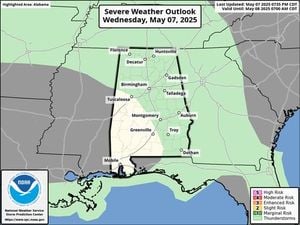The threat of Asteroid 2024 YR4 has raised global concerns as scientists work to track its potential collision with Earth, scheduled for December 22, 2032. With its size ranging between 40 and 100 meters, it has been dubbed 'the city destroyer' due to the significant devastation it could cause upon impact.
According to the Daily Mail, the asteroid's power upon impact could equal 8 megatons of TNT, making it more than 500 times stronger than the Hiroshima atomic bomb. The resulting explosion could obliterate metropolitan areas, devastating cities such as London, where damage could extend from Westminster to Croydon, affecting smaller towns as well.
NASA experts confirm the asteroid currently has approximately a 2.3% chance of hitting Earth, which translates to about one in 43. This probability is alarming, especially considering it is significantly higher than previous estimates of 1.3%. Its impending close approach is set for 2032, raising urgent questions about how to prepare for such event.
The collaborative international effort to keep track of 2024 YR4 involves sophisticated technology including telescopes like the James Webb Space Telescope and ATLAS, employed by NASA and the European Space Agency (ESA). "Astronomers are using powerful telescopes to measure the asteroid’s orbit as accurately as possible. But knowing its orbit will only tell us it could impact Earth, not how significant the impact could be," remarked a spokesperson from ESA.
This asteroid is particularly concerning because, if it collides with Earth, its impact damage could radiate up to 8.8 kilometers (approximately 5.5 miles) away, endangering lives and infrastructure. Areas as far as 19 kilometers away from the impact site could face lethal consequences.
Countries potentially affected span from South America to Asia and Africa, including Venezuela, Colombia, Ecuador, India, Pakistan, Bangladesh, Ethiopia, Sudan, and Nigeria. The report highlights the need for greater awareness and preparedness as it relates to safety measures for populations living within the predicted risk corridor.
The potential outcome of such an asteroid impact draws comparisons to the Tunguska event of 1908, when an asteroid exploded over a remote area of Siberia, flattening 830 square miles of forest. Expert David Rankin from NASA's Catalina Sky Survey Project has noted the impact radius could range significantly, mapping out the risk corridor stretching from northern South America across the Pacific Ocean to southern Asia, the Arabian Sea, and parts of Africa.
Despite these concerning predictions, NASA insists there is no immediate cause for alarm. The agency continues to monitor 2024 YR4 closely. “It’s not something to lose sleep over just yet...but we must remain vigilant,” noted one NASA engineer, who emphasized the localized damage potential rather than apocalyptic scenarios.
The impact prediction analysis includes assessments of the asteroid's orbital patterns, which have become increasingly refined thanks to advancements in detection technologies. Future observational campaigns, especially close observations during the asteroid's near pass within 5 million miles of Earth scheduled for 2028, are expected to provide more definitive data.
Interestingly, some experts believe there could be good news: previous threats have sometimes been downgraded as scientists gather more data through astrometric observations. The challenge lies not only in determining the asteroid's path but also its physical characteristics, which can vary dramatically between 40 meters and 90 meters.
The sources confirm there is still time to mitigate risks should asteroid impact likelihood increase. With predictions and data rapidly changing, the assessment of whether 2024 YR4 should eventually be classified as a threat remains to be seen.
NASA classifies 2024 YR4 as level 3 on the Torino Impact Hazard Scale, indicating it merits attention due to its near approach. This level suggests it is significant enough to warrant close scrutiny by astronomers worldwide.
While many of us may dismiss the topic of asteroid collision as mere science fiction fodder, the serious work being done by experts worldwide emphasizes the importance of caution and preparedness for such astronomical events. With data tracking efforts underway, the race against time takes on new meaning as December 2032 approaches.
Only time will tell if these estimates will hold, but for today, every observation counts as we continue to look up to the skies.



